Experimental Investigation of Task Performance and Human Vigilance in Different Noise Environments
Abstract
:1. Introduction
2. Materials and Methods
2.1. Study Design
2.2. Experimentation
2.2.1. MATB Task
2.2.2. NASA-TLX Scale
2.2.3. SampEn of HRV
- (1)
- The vector distance between vector and vector was defined as the maximum absolute difference between their corresponding elements (Equation (3))
- (2)
- Given a similar capacity r (r > 0), the number of j satisfying the formula (Equations (4) and (5)) was counted and denoted as Bi.Then, for ,
- (3)
- of the average value of i, was represented as (see Equation (6)).
- (4)
- Another m + 1 vectors were constructed with above steps to obtain . Then, the SampEn could be estimated as:
2.2.4. PVT
2.3. Experimental Set-Up
2.4. Experimental Procedure
2.5. Statistical Analysis
3. Results
3.1. Effects of Noise Parameters
3.2. Effects of Mental Workload
3.3. Interactive Effects on Task Performance
4. Discussion
5. Conclusions
Author Contributions
Funding
Institutional Review Board Statement
Informed Consent Statement
Data Availability Statement
Acknowledgments
Conflicts of Interest
References
- Basner, M.; Babisch, W.; Davis, A.; Brink, M.; Clark, C.; Janssen, S.; Stansfeld, S. Auditory and non-auditory effects of noise on health. Lancet 2014, 383, 1325–1332. [Google Scholar] [CrossRef] [Green Version]
- Zare Sakhvidi, M.J.; Zare Sakhvidi, F.; Mehrparvar, A.H.; Foraster, M.; Dadvand, P. Association between noise exposure and diabetes: A systematic review and meta-analysis. Environ. Res. 2018, 166, 647–657. [Google Scholar] [CrossRef] [PubMed]
- van Kempen, E.; Babisch, W. The quantitative relationship between road traffic noise and hypertension: A meta-analysis. J. Hypertens. 2012, 30, 1075–1086. [Google Scholar] [CrossRef] [PubMed] [Green Version]
- de Kluizenaar, Y.; van Lenthe, F.J.; Visschedijk, A.J.; Zandveld, P.Y.; Miedema, H.M.; Mackenbach, J.P. Road traffic noise, air pollution components, and cardiovascular events. Noise Health 2013, 15, 388–397. [Google Scholar] [CrossRef]
- Ke, J.; Du, J.; Luo, X. The effect of noise content and level on cognitive performance measured by elec-troencephalography (EEG). Autom. Constr. 2021, 130, 103836. [Google Scholar] [CrossRef]
- Monteiro, R.; Tomé, D.; Neves, P.; Silva, D.; Rodrigues, M.A. The interactive effect of occupational noise on attention and short-term memory: A pilot study. Noise Health 2018, 20, 190–198. [Google Scholar]
- Irgens-Hansen, K.; Gundersen, H.; Sunde, E.; Baste, V.; Harris, A.; Bråtveit, M.; Moen, B.E. Noise exposure and cognitive performance: A study on personnel on board Royal Norwegian Navy vessels. Noise Health 2015, 17, 320–327. [Google Scholar] [CrossRef] [Green Version]
- Broadbent, D.E. The current state of noise research: Reply to Poulton. Psychol. Bull. 1978, 85, 1052–1067. [Google Scholar] [CrossRef]
- Smith, A. Noise, performance efficiency and safety. Int. Arch. Occup. Environ. Health 1990, 62, 1–5. [Google Scholar] [CrossRef]
- Robinson, O.J.; Vytal, K.; Cornwell, B.R.; Grillon, C. The impact of anxiety upon cognition: Perspectives from human threat of shock studies. Front. Hum. Neurosci. 2013, 7, 203. [Google Scholar] [CrossRef] [Green Version]
- Patel, N.; Vytal, K.; Pavletic, N.; Stoodley, C.; Pine, D.S.; Grillon, C.; Ernst, M. Interaction of threat and verbal working memory in adolescents. Psychophysiology 2016, 53, 518–526. [Google Scholar] [CrossRef] [PubMed]
- Koelega, H.S.; Brinkman, J.A. Noise and vigilance: An evaluative review. Human Factors 1986, 28, 465–481. [Google Scholar] [CrossRef] [PubMed]
- Button, C.D.; Behm, G.D.; Holmes, M.; Mackinnon, N.S. Noise and muscle contraction affecting vigilance task performance. Occup. Ergon. 2004, 4, 157–171. [Google Scholar] [CrossRef]
- Smith, A.P. Acute effects of noise exposure: An experimental investigation of the effects of noise and task parameters on cognitive vigilance tasks. Int. Arch. Occup. Environ. Health 1988, 60, 307–310. [Google Scholar] [CrossRef]
- Lin, C.; Nascimben, M.; King, J.; Wang, Y. Task-related EEG and HRV entropy factors under different re-al-world fatigue scenarios. Neurocomputing 2018, 311, 24–31. [Google Scholar] [CrossRef]
- Wang, F.; Xu, Q.; Fu, R.; Sun, G. Study of driving skill level discrimination based on human physiological signal characteristics. RSC Adv. 2018, 8, 42160–42169. [Google Scholar] [CrossRef] [PubMed] [Green Version]
- Richman, J.; Moorman, J.R. Physiological time-series analysis using approximate entropy and sample en-tropy. American journal of physiology. Heart Circ. Physiol. 2000, 278, H2039–H2049. [Google Scholar] [CrossRef] [Green Version]
- Pincus, S.M. Approximate entropy as a measure of system complexity. Proc. Natl. Acad. Sci. USA 1991, 88, 2297–2301. [Google Scholar] [CrossRef] [Green Version]
- Comstock, J.R. Mat-Multi-Attribute Task Battery for Human Operator Workload and Strategic Behavior Research. 1995. Available online: https://xueshu.baidu.com/usercenter/paper/show?paperid=1b090tr00f730060y94v08y09b694508&site=xueshu_se&hitarticle=1 (accessed on 19 October 2022).
- Fairclough, S.H.; Venables, L.; Tattersall, A. The influence of task demand and learning on the psycho-physiological response. Int. J. Psychophysiol. 2005, 56, 171–184. [Google Scholar] [CrossRef]
- Zhang, J.; Pang, L.; Cao, X.; Wanyan, X.; Wang, X.; Liang, J.; Zhang, L. The effects of elevated carbon dioxide concentration and mental workload on task performance in an enclosed environmental chamber. Build. Environ. 2020, 178, 106938. [Google Scholar] [CrossRef]
- Hart, S.G.; Staveland, L.E. Development of NASA-TLX (Task Load Index): Results of Empirical and The-oretical Research. Adv. Psychol. 1988, 52, 139–183. [Google Scholar]
- Ramiro, E.M.; Valdehita, S.R.; García, J.L.; Moreno, L. Estudio Psicométrico del Índice de Carga Mental NASA-TLX con una Muestra de Trabajadores Españoles. Rev. Psicol. Trab. Organ. 2010, 26, 191–199. [Google Scholar]
- Song, Y.; Lio’, P. A new approach for epileptic seizure detection: Sample entropy based feature extraction and extreme learning machine. J. Biomed. Sci. Eng. 2010, 3, 556–567. [Google Scholar] [CrossRef]
- Bermudez, E.B.; Klerman, E.B.; Czeisler, C.A.; Cohen, D.A.; Wyatt, J.K.; Phillips, A.J. Prediction of Vigilant Attention and Cognitive Performance Using Self-Reported Alertness, Circadian Phase, Hours since Awakening, and Accumulated Sleep Loss. PLoS ONE 2016, 11, e0151770. [Google Scholar] [CrossRef] [PubMed] [Green Version]
- Fastl, H.; Zwicker, E. Psychoacoustics: Facts and Models; Springer Science & Business Media: Berlin/Heidelberg, Germany, 1990. [Google Scholar]
- Hu, Z.Y.; Shi, X.F.; Liang, Z.F. Discussion on noise level in submarine cabin during navigation. Chin. J. Marine Med. 1997, 69–71. [Google Scholar]
- ISO 7933; Ergonomics of the Thermal Environment–Analytical Determination and Interpretation of Heat Stress Using Calculation of the Predicted Heat Strain. ISO: Geneva, Switzerland, 2004.
- ANSI/ASHRAE 55-2010; Thermal Environmental Conditions for Human Occupancy. American Society of Heating, Refrigerating and Air-Conditioning Engineers: Atlanta, GA, USA, 2010.
- Rueb, J.D.; Vidulich, M.A.; Hassoun, J.A. Establishing Workload Acceptability: An Evaluation of a Pro-posed Kc-135 Cockpit Redesign. Proc. Hum. Factors Ergon. Soc. Annu. Meet. 1992, 36, 17–21. [Google Scholar] [CrossRef]
- Yang, C.; Yang, L.; Cheng, T.; Jou, Y.; Chiou, S. Assessing mental workload and situation awareness in the evaluation of computerized procedures in the main control room. Nucl. Eng. Des. 2012, 250, 713–719. [Google Scholar] [CrossRef]
- Shkembi, A.; Smith, L.M.; Le, A.B.; Neitzel, R.L. Noise exposure and mental workload: Evaluating the role of multiple noise exposure metrics among surface miners in the US Midwest. Appl. Ergon. 2022, 103, 103772. [Google Scholar] [CrossRef]
- Golmohammadi, R.; Darvishi, E.; Faradmal, J.; Poorolajal, J.; Aliabadi, M. Attention and short-term memory during occupational noise exposure considering task difficulty. Appl. Acoust. 2020, 158, 107065. [Google Scholar] [CrossRef]
- Szalma, J.L.; Hancock, P.A. Noise effects on human performance: A meta-analytic synthesis. Psychol. Bull. 2011, 137, 682–707. [Google Scholar] [CrossRef] [Green Version]
- Helton, W.S.; Matthews, G.; Warm, J.S. Stress state mediation between environmental variables and per-formance: The case of noise and vigilance. Acta Psychol. 2009, 130, 204–213. [Google Scholar] [CrossRef] [PubMed]
- De Waard, D.; Brookhuis, K.A. On the measurement of driver mental workload. In Traffic and Transport Psychology. Theory and Application; Elsevier: Amsterdam, The Netherlands, 1997; pp. 161–171. Available online: https://trid.trb.org/view/635112 (accessed on 19 October 2022).
- Elmenhorst, E.; Elmenhorst, D.; Wenzel, J.; Quehl, J.; Mueller, U.; Maass, H.; Vejvoda, M.; Basner, M. Effects of nocturnal aircraft noise on cognitive performance in the following morning: Dose–response relationships in la-boratory and field. Int. Arch. Occup. Environ. Health 2010, 83, 743–751. [Google Scholar] [CrossRef] [PubMed]
- Wu, Q. Research on Driving Fatigue Detection Method Based on ECG Signal. Ph.D. Thesis, Zhejiang University, Hangzhou, China, 2008. [Google Scholar]
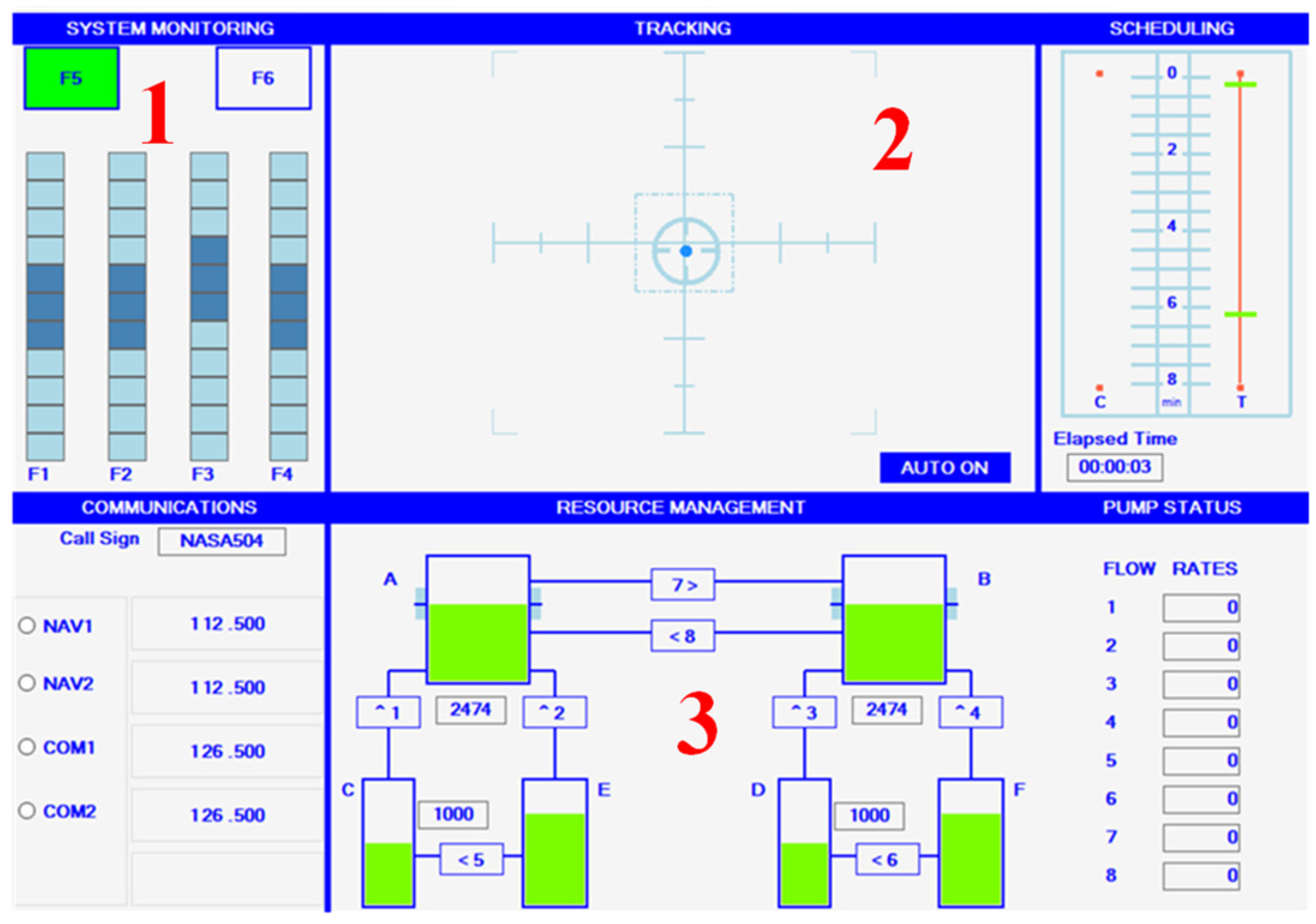
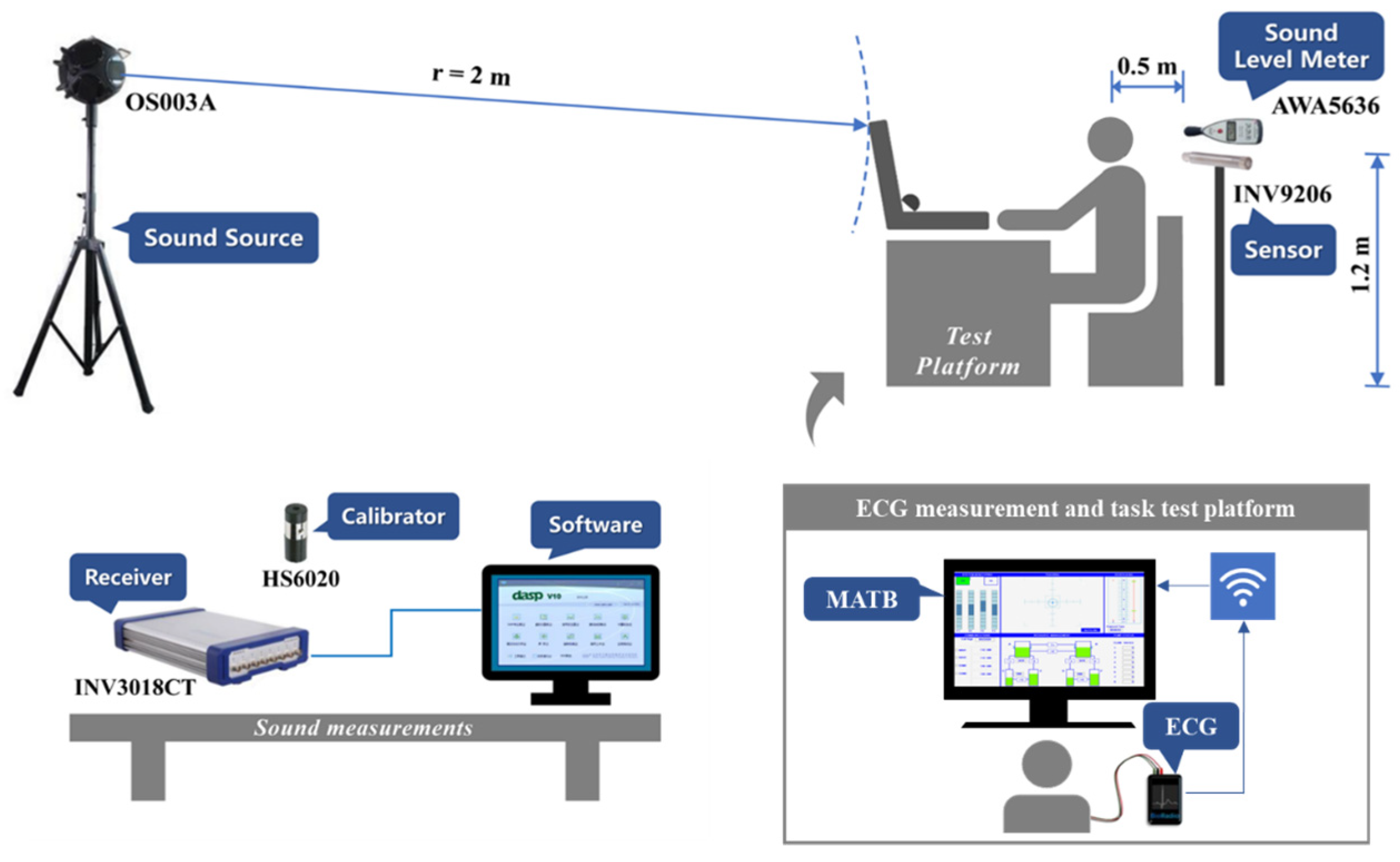

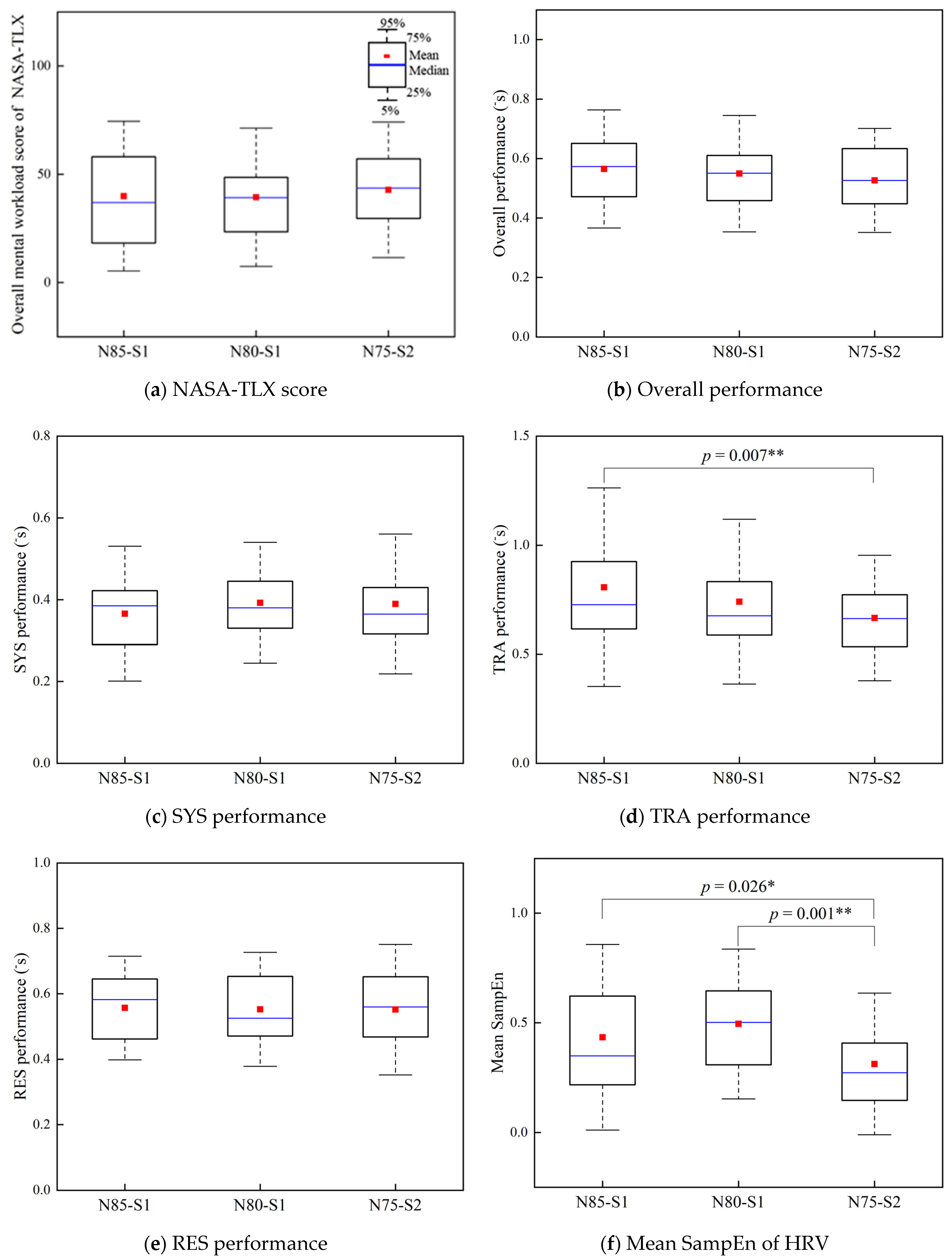
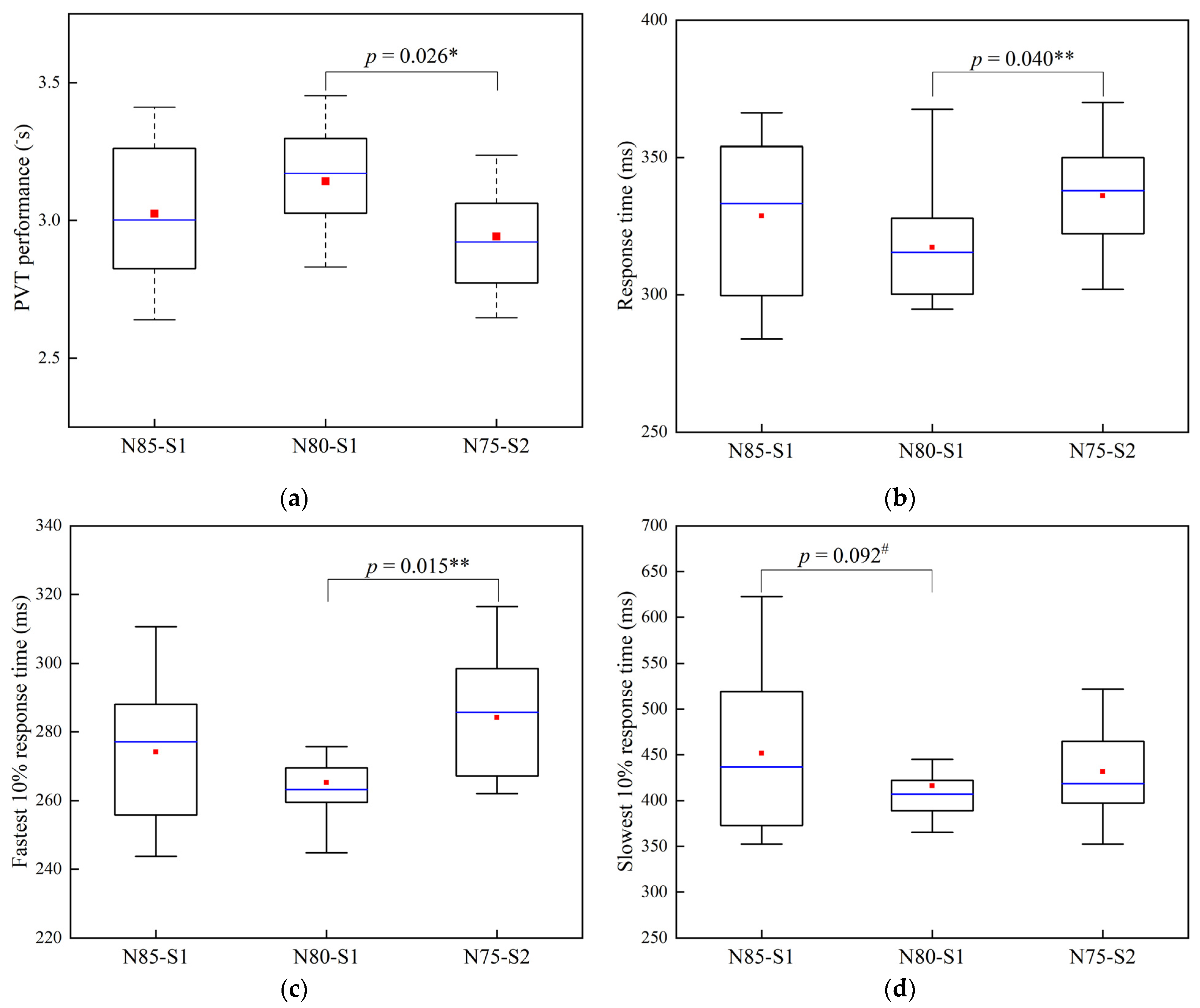
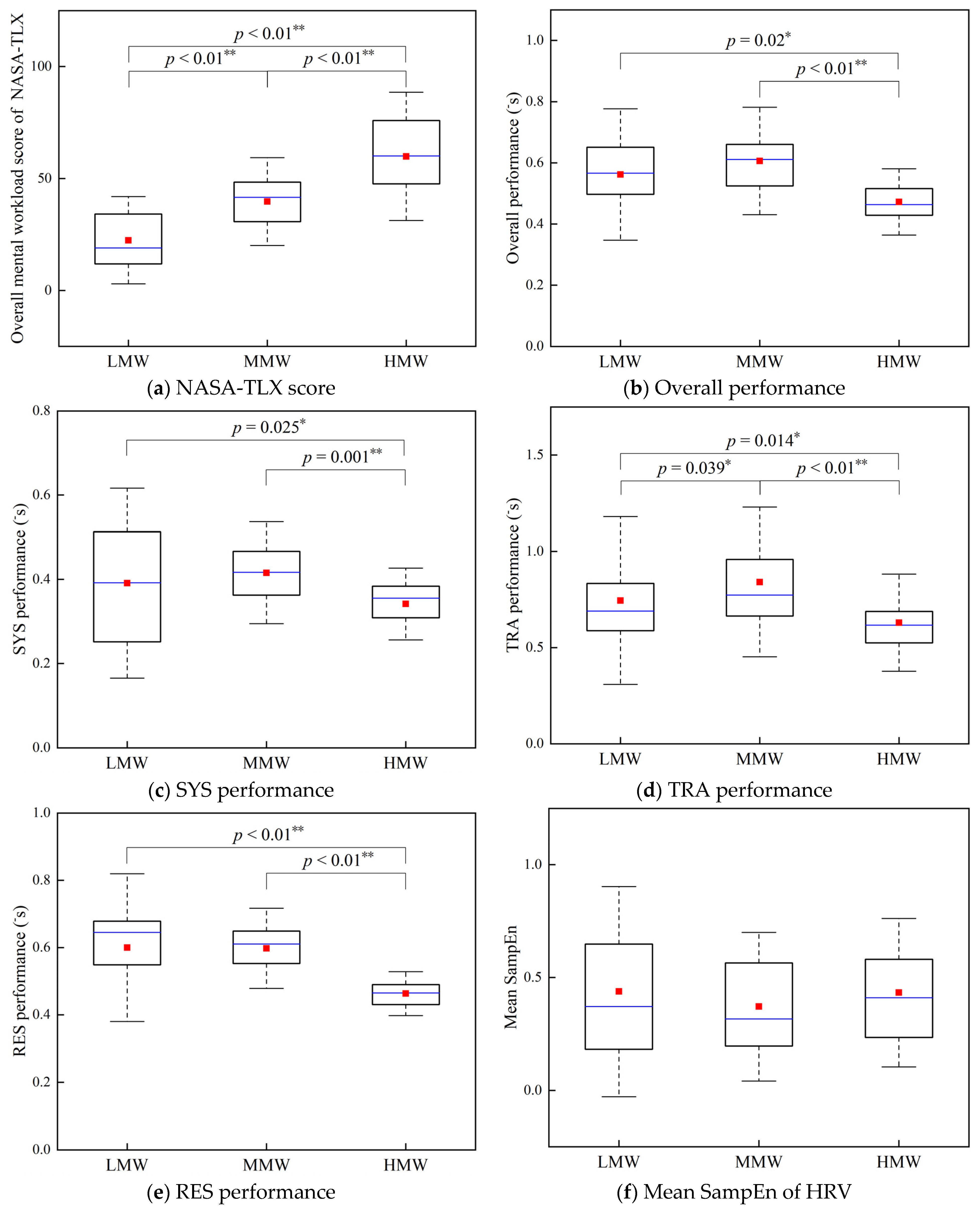
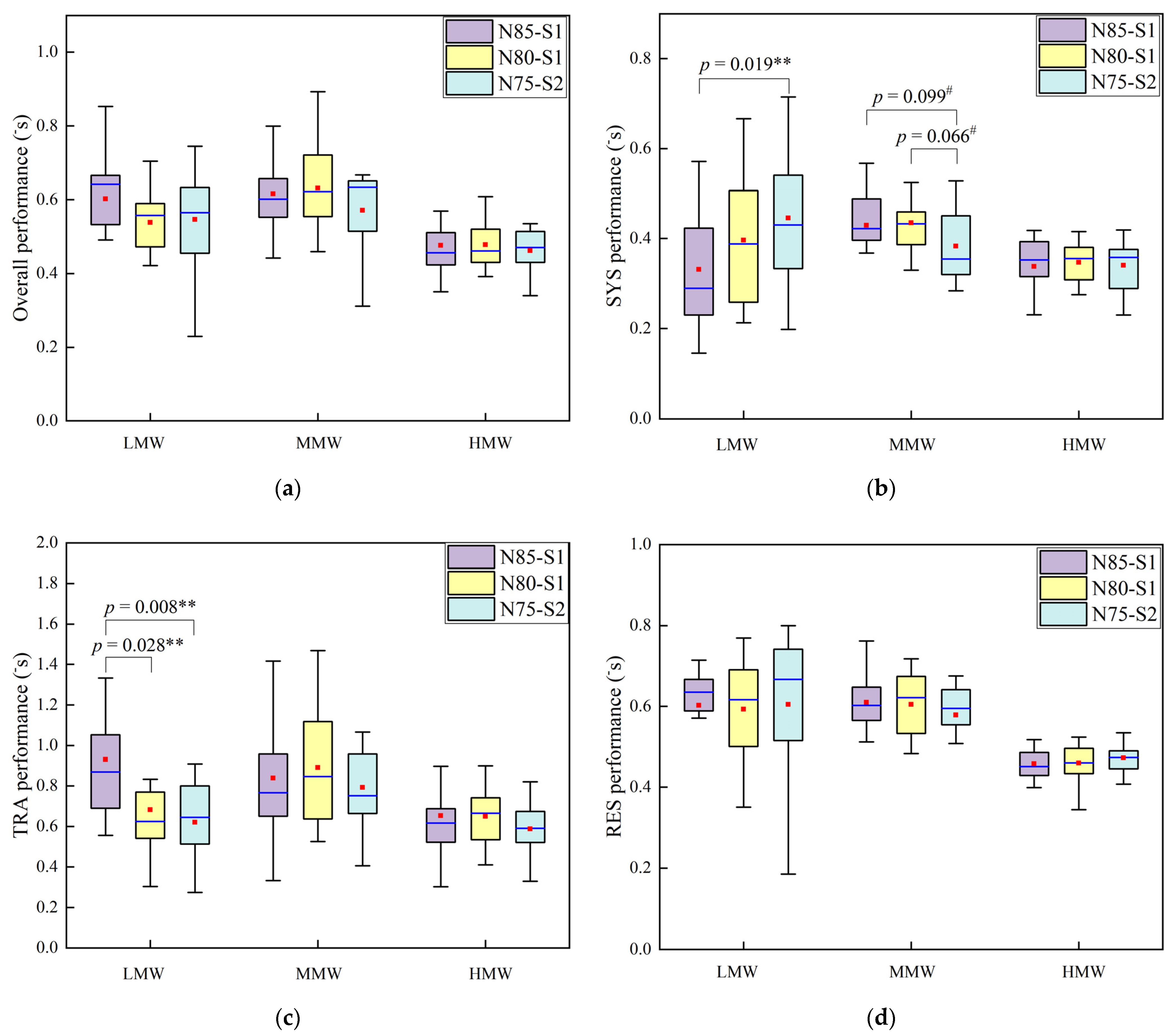
| Subtask | Area | Instruction |
|---|---|---|
| SYS | 1 | Monitor the scales of F1–F4 and click the corresponding scale with the mouse when the dynamic targets touch the upper or lower three bars of any scale. |
| TRA | 2 | Keep the target at the grid center by joystick in MANUAL mode and no action is required in AUTO mode. |
| RES | 3 | Monitor the status of pumps numbered 1–8 and click the corresponding pump with the mouse when a failure occurs. |
| PVT Metrics | Description |
|---|---|
| PVT performance (-s) | The ratio of accuracy to average response times. |
| Response time (ms) | The average response times for all trials. |
| Fastest 10% response time (ms) | The fastest 10% response times for all trials. |
| Slowest 10% response time (ms) | The slowest 10% reciprocal response times for all trials. |
| Environmental Parameters | N85-S1 | N80-S1 | N75-S2 |
|---|---|---|---|
| LAeq (dB(A)) | 84.2 ± 0.8 | 78.3 ± 0.7 | 75.0 ± 0.8 |
| Noise sharpness (acum) | 1.28 ± 0.03 | 1.30 ± 0.03 | 2.42 ± 0.04 |
| Air temperature (°C) | 20.9 ± 0.6 | 21.0 ± 0.6 | 21.1 ± 0.6 |
| Relative humidity (%) | 26.5 ± 8.1 | 29.0 ± 7.5 | 24.7 ± 5.6 |
| Air velocity (m/s) | 0.12 ± 0.01 | 0.13 ± 0.01 | 0.12 ± 0.01 |
| Black globe temperature (°C) | 21.1 ± 0.6 | 21.2 ± 0.6 | 21.3 ± 0.5 |
Publisher’s Note: MDPI stays neutral with regard to jurisdictional claims in published maps and institutional affiliations. |
© 2022 by the authors. Licensee MDPI, Basel, Switzerland. This article is an open access article distributed under the terms and conditions of the Creative Commons Attribution (CC BY) license (https://creativecommons.org/licenses/by/4.0/).
Share and Cite
Yang, C.; Pang, L.; Liang, J.; Cao, X.; Fan, Y.; Zhang, J. Experimental Investigation of Task Performance and Human Vigilance in Different Noise Environments. Appl. Sci. 2022, 12, 11376. https://doi.org/10.3390/app122211376
Yang C, Pang L, Liang J, Cao X, Fan Y, Zhang J. Experimental Investigation of Task Performance and Human Vigilance in Different Noise Environments. Applied Sciences. 2022; 12(22):11376. https://doi.org/10.3390/app122211376
Chicago/Turabian StyleYang, Chenyuan, Liping Pang, Jin Liang, Xiaodong Cao, Yurong Fan, and Jie Zhang. 2022. "Experimental Investigation of Task Performance and Human Vigilance in Different Noise Environments" Applied Sciences 12, no. 22: 11376. https://doi.org/10.3390/app122211376
APA StyleYang, C., Pang, L., Liang, J., Cao, X., Fan, Y., & Zhang, J. (2022). Experimental Investigation of Task Performance and Human Vigilance in Different Noise Environments. Applied Sciences, 12(22), 11376. https://doi.org/10.3390/app122211376







